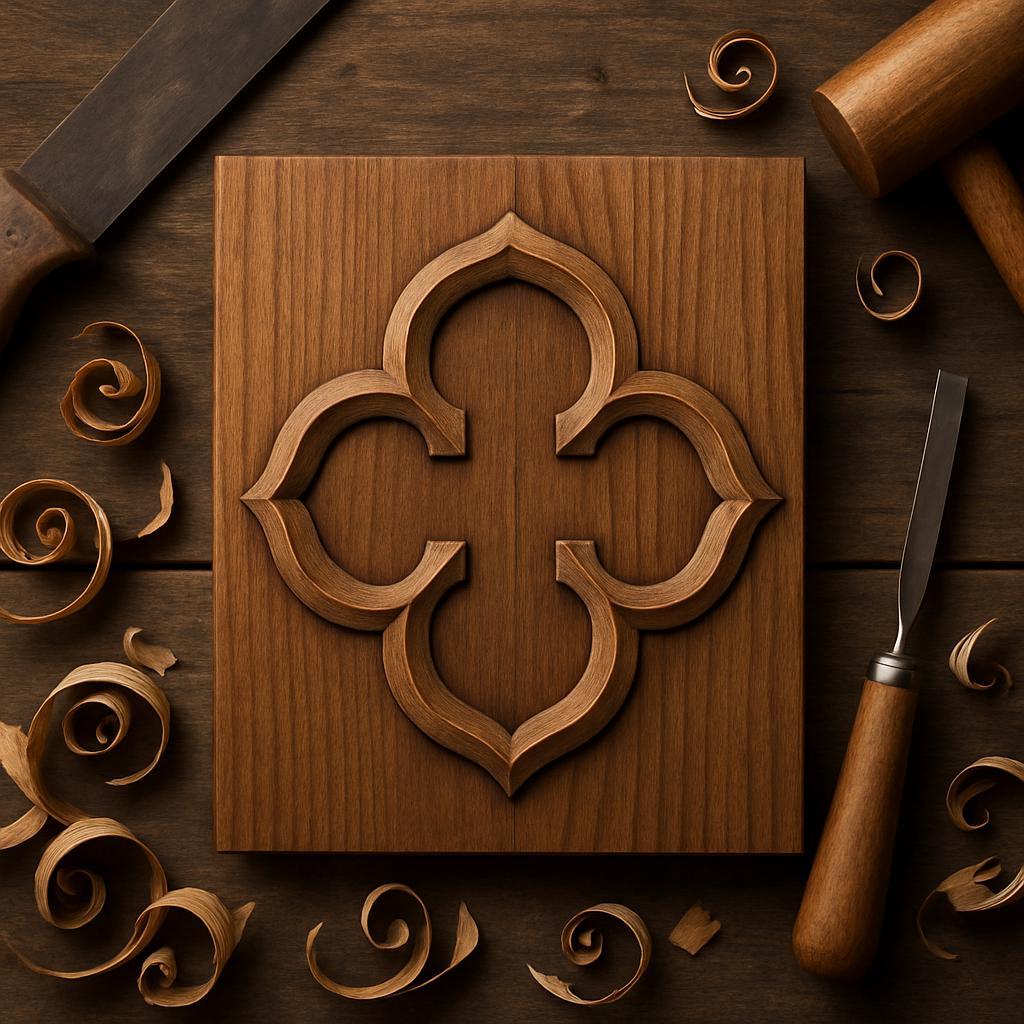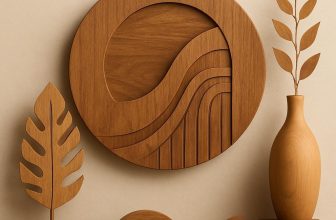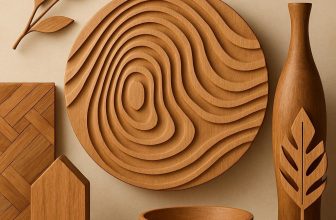
There's a quiet magic in wood that looks aged yet feels fresh with every use. Rustic woodworking taps into that harmony, proving that classic lines adn honest materials never go out of fashion.For enthusiasts, these designs are more than aesthetics; they're a bridge between skill and soul, a toolkit of sturdy techniques, simple joinery, and expressive shapes that age gracefully. In this article, you'll explore iconic rustic styles, learn how to select sustainable timbers, achieve weathered finishes, and mix rough-hewn charm with modern joinery. By the end, you'll have actionable ideas to bring timeless warmth into your projects and workshops.
Selecting Rustic Woods for Timeless Projects
Selecting rustic woods begins with reading the story in the grain. Look for boards that carry age-worn character-tight, even growth rings, subtle spalting, and the kind of knots that tell you a piece has lived a long life. prioritize materials whose condition can withstand hands-on projects: stability for joints, and a surface that invites finish rather than fights it. When you inspect stock, check for cracks, checks, or heavy warping, and prefer less movement where a project requires precision components. A true timeless piece balances authentic character with structural reliability.
Decide between reclaimed or new timber. Reclaimed wood offers history and texture, but accept variability in size and moisture. from reputable suppliers reduces shrinkage and makes assembly smoother. For any wood,aim for a moisture content around 6-8% for interior pieces,and acclimate boards in your shop before cutting. Plan for seasonal movement by predrilling and leaving room for expansion in joins, and seal against moisture in kitchens and baths with a durable, evenly applied finish.
Here is a quick guide to common rustic woods you'll encounter, distilled into practical takeaways.
| Wood Type | Characteristic | Best For | Trade-off |
|---|---|---|---|
| Reclaimed Oak | Rich grain, weathered patina | Tables, beams, shelving | Variability; knots |
| Rustic Pine | Warm hue, visible character | Cabin-style furniture, paneling | Scratch-prone; needs sealing |
| Cedar | Natural rot resistance, light weight | Outdoor furniture, storage chests | Softness; color darkens with sun |
| Walnut | Deep, chocolate tones | Fine-detail pieces, countertops | Higher cost; heavier to work |
Finish and care are the final brushstrokes that lock rustic beauty in place. For interior pieces, choose a finish that respects the wood's warmth-an oil or matte polyurethane that enhances grain without adding glare. Apply with a rag or brush, wipe excess, and cure in a dust-free environment. Regular maintenance is simple: dust with a soft cloth, reapply a conditioner or oil every few years for high-usage pieces, and avoid harsh cleaners that strip the patina. Local or responsibly sourced woods reduce environmental impact and support regional craftspeople, helping your timeless project stay grounded in place.
Build Your Dream Workshop on a Budget →
Mastering Classic Rustic Joinery for Stronger Pieces
Strong rustic pieces rely on joints that stay tight through changing humidity and heavy use. Ground your builds in a handful of time-tested connections: mortise-and-tenon joints (often wedged for extra grip),dovetail corners for drawers and boxes,and drawbored mortise-and-tenon assemblies that resist pulling apart without visible hardware. Start by choosing stock with straight grain and similar moisture content, then lay out the joints with care. After that, cut the mortises and tenons in patient, shallow steps, checking fit frequently so each intersection sings with a snug, clean reveal.
Plan the workflow around stability: mark shoulders and cheeks with a sharp marking gauge, then cut mortises with a sharp chisel and boring tool, test-fit after each removal. When shaping the tenon, take small, equal reductions on each cheek to preserve parallel faces; for added rustic strength, consider a wedge on through or haunched mortise-and-tenon to lock the joint.For interiors, a peg or a drawbore pin can keep the assembly tight as wood moves. smooth the surfaces with light sanding to preserve the tactile, hand-made character.
| Joint Type | Best For | Key Benefit |
|---|---|---|
| Mortise-and-Tenon | Frames, legs to rails | Strong, durable connections |
| dovetail | Boxes, drawers, corners | Excellent resistance to pull-apart forces |
| Drawbored Mortise-and-Tenon | Furniture frames | Locking without visible fasteners |
Finish with intention: test-fit under climate variability, then clamp firmly and check for even gaps along shoulders. Use a light oil or wax finish to let the wood breathe and age gracefully, avoiding heavy coatings that can crack as joints move. embrace the ritual of maintenance-seasonal checks, re-tightening wedges, and occasional touch-ups-so your rustic pieces grow more character with every season.
Build Your Dream Workshop on a Budget →
Finishing techniques that Honor Grain and Longevity
Choosing a finish that honors the wood's grain means prioritizing penetration and clarity over thick, opaque coats. Favor penetrating oils (tung oil, linseed oil, or polymerized variations) or a light shellac conditioning step that enhances depth without masking figure. Apply thin, even coats with a clean cloth or a high-quality brush, wipe off any excess, and let each layer cure fully before the next. The goal is a subtle glow that emphasizes the wood's natural patterns rather than a glossy film.
Preparation matters as much as the finish. Begin with the right abrasive sequence-wet-sanding up to 400 grit for a smooth surface, then remove all dust. When grain lines are prominent, consider a light pore-filler for highly figured woods so the subsequent coats sit evenly. Choose a topcoat that pairs with your environment: a water-based polyurethane for color preservation and quick cures, or an oil-based polyurethane or spar varnish for amber warmth and outdoor longevity. Apply in several ultra-thin coats, sanding lightly between coats (320-400 grit) to keep the grain crisp rather than glazed over.
Protection is maintenance in disguise. UV exposure and humidity can dull grain over time, so select finishes with UV inhibitors or add a clear UV-enhancing topcoat. For interior pieces, a satin or semi-gloss film can highlight grain while concealing wear; for outdoor pieces, lean toward a durable spar varnish with a flexible film. After curing, maintain the surface with dusting and occasional buffing with a paste wax or conditioning wax to restore luster without building a thick layer that hides grain.
| Finish Type | Grain Impact | Longevity |
|---|---|---|
| Penetrating oil | Enhances natural grain; minimal film | Moderate protection; reapplication needed |
| Water-based polyurethane | Clear, preserves color and grain | High durability; quick cure |
| spar varnish / oil-based polyurethane | Warmer grain; flexible film | Excellent exterior longevity |
Build Your Dream Workshop on a Budget →
Building Rustic Furniture with Simple Tools and Smart Layouts
Crafting rustic furniture begins with a plan that respects the materials and the space it will inhabit. with simple tools and smart layouts, a small workshop can yield sturdy pieces that age gracefully.Start by sketching a few layout options and choosing stock that minimizes waste-thick boards for legs, thinner boards for panels, and straight-grained stock for a calm, timeless look.
Set up a clear cut list before you touch a tool. This keeps the workflow smooth and reduces trips to the lumber rack.The following exmaple shows a lean layout for a small rustic table, keeping length and joinery consistent to maximize yield:
| Part | Length (in) | Quantity | Notes |
|---|---|---|---|
| Table Top | 36 | 1 | planed, straight edges |
| Aprons | 35 | 2 | under-top frame |
| Legs | 18 | 4 | square stock 2.5 in |
| Corner Braces | 16 | 4 | for stability |
Joinery in rustic form often relies on visible methods that are forgiving to amateur woodworkers. Consider through-dowels or lap joints with minimal hardware. A simple half-lap or a single through-dowel can secure a frame without heavy equipment. Clamp blocks and a square guide help you maintain consistent joints, while a rabbit plane or block plane smooths edges to a tactile, weathered feel.
Finish matters as much as structure. Rustic pieces shine with natural oils and waxes that reveal the grain rather than mask it. Wipe on a penetrating oil, let it soak, then buff with a clean cloth. Light sanding through grits 120 to 220 yields a soft, satin surface that invites touch.If you want a bit more character, dampen the wood with a clean rag before oiling to raise the grain for a subtle texture.
Build Your Dream Workshop on a Budget →
Curating Rustic Wood Details and Accents for Cohesive Rooms
when curating rustic wood details for cohesive rooms, start by establishing a unifying material language.Choose a core wood family-say warm oak or weathered pine-and carry its tone across furniture, paneling, and built-ins. Collect small samples or swatches, and assemble a mood board that demonstrates how light, grain, and patina will read in different spaces. Use finishes that sit in the same family-matte oils, waxes, or low-sheen polyurethane-to keep surfaces from feeling disjointed.
Texture is your ally. Layer rough-hewn beams with smoother elements like planed boards, leathers, and linen textiles to keep the look tactile without overwhelming the senses. opt for hardware and hardware finishes that echo the wood's character-hand-forged iron, antique brass, or blackened steel. A single metal finish tied to a handful of accents (lamps, knobs, picture frames) reinforces harmony while allowing the grain to shine.
Integrate curated accents that reinforce a rustic story without clutter. Use reclaimed wood pieces as focal notes-think a mantel, shelving, or a coffee table-that set the tone, then echo with smaller accents: cutting boards, bowls, trays, and frames in similar wood tones. consider a consistent edge detailing (bevels, chamfers, or rounded corners) across items to create visual rhythm. To help visualize, you can reference a simple guide below:
| Finish Family | Best Used For | Example Piece |
|---|---|---|
| Weathered Pine | Wall paneling, mantels | Beams |
| Oak (Natural/Matte) | Tabletops, cabinetry | Dining table |
| Walnut/Deep Oak | Accent furniture | Sideboard |
Plan with a rhythm to ensure every room reads as part of the same family.Use repeating motifs-planked ceilings, ledger boards, or a row of shelves-to guide eye flow from space to space. In smaller rooms, give rugged pieces room to breathe with negative space; in larger rooms, pair a bold focal piece with softer surroundings to maintain balance.A practical rule: one dominant wood story, two supporting textures, and three small accents in the same tone.
Build your Dream Workshop on a Budget →
Caring for Rustic Woodworking Projects to Preserve Character
Preserving the character of rustic woodworking means treating the wood like a living partner-allowing age and use to tell the story. Choose finishes that breathe rather than seal in every crack; this keeps the surface from feeling stiff and allows natural patina to develop. Protect pieces from harsh sunlight and dramatic shifts in humidity, which can cause warping or cracking, and reframe care as a gentle ritual rather than a makeover.
Daily care should be simple and thoughtful. Keep dust to a minimum with a soft microfiber, wipe spills promptly with a barely damp cloth, and dry the surface immediately. When refinishing, prefer conventional, breathable finishes over heavy sealing coats; they soften the transition between old and new and preserve the piece's tactile warmth. The following steps help maintain the vibe without erasing its history:
- Dust regularly with a soft microfiber to prevent scratches.
- Wipe spills or fingerprints with a lightly damp cloth, then dry.
- Avoid silicone-based cleaners and aggressive solvents that can break down the wood's patina.
- Refresh finishes sparingly-test in an inconspicuous area before broader submission.
| Finish | Pros | Best Use |
|---|---|---|
| Oil Finish (tung/linseed) | Deepens color, enhances grain, breathable | Open-grain woods and heirloom pieces |
| Beeswax/Wax Finish | soft luster, easy to refresh, low odor | Furniture surfaces where patina matters |
| Water-based Polyurethane | Durable, clear, quick-drying | High-traffic surfaces while preserving rustic look |
Storage and display also matter. Keep pieces in a stable climate-ideally 40-60% humidity and temperatures that avoid rapid swings. Use protective pads, coasters, and felt under legs to prevent scuffs; rotate display spots away from direct sunlight to slow color changes. Let the wood's history shine through by prioritizing maintenance that preserves texture and grain rather than masking it with heavy coatings.
Build Your Dream Workshop on a Budget →
Q&A
What defines rustic woodworking, and how do I start a project without overdoing it?
Rustic woodworking emphasizes natural materials, visible grain, and honest construction that feels lived-in. Start with a simple project like a bench or coffee table,keep joinery straightforward (mortise-and-tenon or dowels),and choose finishes that enhance grain rather than hide it.
What woods and finishes give a rustic look while staying durable?
Woods such as reclaimed barn wood,pine,oak,or maple with wide planks or natural live edges help achieve the look. Use matte or satin finishes-tung oil, Danish oil, or water-based poly-to protect without adding glare, and avoid heavy gloss that can feel artificial.
How can I balance rustic charm with modern functionality?
Opt for clean lines and sturdy hardware to provide contrast with rough textures. Include practical details like hidden drawers, simple, strong joinery, and durable finishes that stand up to daily use.
What safety and sustainability considerations should I keep in mind?
Source wood responsibly-look for reclaimed material or FSC-certified options. Wear PPE and ensure proper ventilation when finishing; check moisture content before milling or assembly to prevent warping.
insights and Conclusions
Rustic woodworking endures not as of flash, but because honest lines, sturdy joints, and natural finishes grow more character with time. The key takeaway is that timeless design blends function with warmth, letting wood tell its story through careful cuts, patient finishing, and purposeful simplicity. For enthusiasts, this matters: it honors craft, builds skills, and yields pieces that age gracefully alongside their makers.So pick up a project, whether a simple bench or a thrift-updated cabinet, and apply these ideas: measure well, choose lumber thoughtfully, embrace flaws as texture.Explore more guides, experiment, and create with confidence-the workshop awaits, inviting you to leave your mark.







These designs truly capture the timeless beauty of nature and craftsmanship; they really bring warmth to any space!
Absolutely agree with you, Charles! There’s something so inviting about rustic woodworking that creates a cozy atmosphere, making it a perfect choice for any home décor!
I couldn’t agree more! Rustic woodworking truly embodies the charm of natural materials, and each piece tells its own story while adding character to our homes.
Totally with you all! Rustic woodworking not only adds warmth and character but also connects us to nature; each piece enhances our spaces with its unique story and craftsmanship.
Totally with you all! Rustic woodworking not only adds warmth and character but also connects us to nature; each piece enhances our spaces with its unique story and craftsmanship.
I completely agree with all of you! Rustic woodworking not only brings a unique aesthetic to our homes but also celebrates the beauty of natural materials, making every piece a conversation starter and a cherished part of our living spaces.
I completely resonate with your thoughts! Rustic woodworking truly provides a sense of warmth and nostalgia, effortlessly enhancing any living space while celebrating the craftsmanship and stories behind each piece.
I wholeheartedly support your views! Rustic woodworking not only enriches our homes with its organic beauty but also serves as a testament to skilled craftsmanship, creating unique and enduring pieces that can be cherished for generations.
I couldn’t agree more! Rustic woodworking captures the essence of nature and craftsmanship, providing a unique charm that transforms any space into a warm, inviting haven filled with character and history.
Absolutely! Rustic woodworking embodies a timelessness and authenticity that not only elevates our interiors but also connects us to the craftsmanship and natural beauty of the materials, making every piece a treasured addition to our homes.
Absolutely, rustic woodworking has a way of telling stories through its imperfections and natural elegance, creating an inviting atmosphere that reminds us of the simpler, more beautiful aspects of life while adding a touch of character to any room.
I totally agree! The beauty of rustic woodworking lies in its ability to blend tradition with functionality, creating not just beautiful pieces but also a connection to nature and a sense of history in our homes.
I completely resonate with all your thoughts! The charm of rustic woodworking lies in its raw, natural appeal and the way it seamlessly integrates into various decor styles, bringing warmth and a sense of belonging to any environment, making each piece not just furniture, but a story waiting to be told.
I completely agree with everyone here! There’s something so special about rustic woodworking; each piece feels like it carries with it a slice of nature and a touch of history, bringing a comforting warmth and a unique character to our homes that new, mass-produced items simply can’t replicate.
I wholeheartedly agree with all the wonderful sentiments shared here! Rustic woodworking truly brings a sense of warmth and authenticity to our spaces, reminding us of the beauty in nature’s imperfections while offering a perfect blend of aesthetics and functionality that can be cherished for years to come.